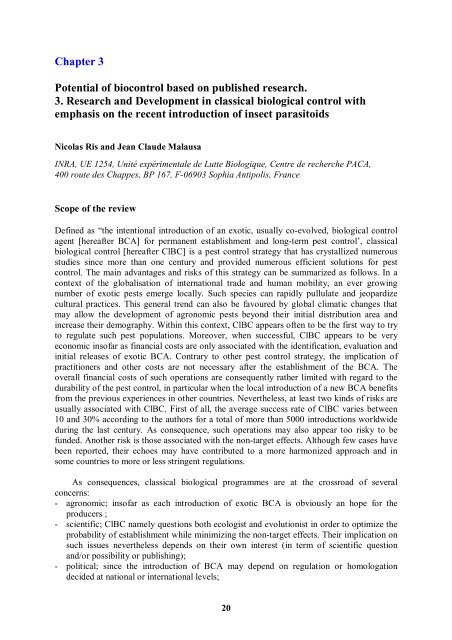Classical and augmentative biological control against ... - IOBC-WPRS
Classical and augmentative biological control against ... - IOBC-WPRS
Classical and augmentative biological control against ... - IOBC-WPRS
You also want an ePaper? Increase the reach of your titles
YUMPU automatically turns print PDFs into web optimized ePapers that Google loves.
Chapter 3<br />
Potential of bio<strong>control</strong> based on published research.<br />
3. Research <strong>and</strong> Development in classical <strong>biological</strong> <strong>control</strong> with<br />
emphasis on the recent introduction of insect parasitoids<br />
Nicolas Ris <strong>and</strong> Jean Claude Malausa<br />
INRA, UE 1254, Unité expérimentale de Lutte Biologique, Centre de recherche PACA,<br />
400 route des Chappes, BP 167, F-06903 Sophia Antipolis, France<br />
Scope of the review<br />
Defined as “the intentional introduction of an exotic, usually co-evolved, <strong>biological</strong> <strong>control</strong><br />
agent [hereafter BCA] for permanent establishment <strong>and</strong> long-term pest <strong>control</strong>’, classical<br />
<strong>biological</strong> <strong>control</strong> [hereafter ClBC] is a pest <strong>control</strong> strategy that has crystallized numerous<br />
studies since more than one century <strong>and</strong> provided numerous efficient solutions for pest<br />
<strong>control</strong>. The main advantages <strong>and</strong> risks of this strategy can be summarized as follows. In a<br />
context of the globalisation of international trade <strong>and</strong> human mobility, an ever growing<br />
number of exotic pests emerge locally. Such species can rapidly pullulate <strong>and</strong> jeopardize<br />
cultural practices. This general trend can also be favoured by global climatic changes that<br />
may allow the development of agronomic pests beyond their initial distribution area <strong>and</strong><br />
increase their demography. Within this context, ClBC appears often to be the first way to try<br />
to regulate such pest populations. Moreover, when successful, ClBC appears to be very<br />
economic insofar as financial costs are only associated with the identification, evaluation <strong>and</strong><br />
initial releases of exotic BCA. Contrary to other pest <strong>control</strong> strategy, the implication of<br />
practitioners <strong>and</strong> other costs are not necessary after the establishment of the BCA. The<br />
overall financial costs of such operations are consequently rather limited with regard to the<br />
durability of the pest <strong>control</strong>, in particular when the local introduction of a new BCA benefits<br />
from the previous experiences in other countries. Nevertheless, at least two kinds of risks are<br />
usually associated with ClBC. First of all, the average success rate of ClBC varies between<br />
10 <strong>and</strong> 30% according to the authors for a total of more than 5000 introductions worldwide<br />
during the last century. As consequence, such operations may also appear too risky to be<br />
funded. Another risk is those associated with the non-target effects. Although few cases have<br />
been reported, their echoes may have contributed to a more harmonized approach <strong>and</strong> in<br />
some countries to more or less stringent regulations.<br />
As consequences, classical <strong>biological</strong> programmes are at the crossroad of several<br />
concerns:<br />
- agronomic; insofar as each introduction of exotic BCA is obviously an hope for the<br />
producers ;<br />
- scientific; ClBC namely questions both ecologist <strong>and</strong> evolutionist in order to optimize the<br />
probability of establishment while minimizing the non-target effects. Their implication on<br />
such issues nevertheless depends on their own interest (in term of scientific question<br />
<strong>and</strong>/or possibility or publishing);<br />
- political; since the introduction of BCA may depend on regulation or homologation<br />
decided at national or international levels;<br />
20

















